Video conference notes 30 April 2015 - Migrations
SWIFFT video conference notes are a summary of the video conference and not intended to be a definitive record of presentations made and issues discussed.
This video conference was supported through resources and technology provided by the Department of Environment, Land, Water and Planning, Victoria. SWIFFT wishes to thank speakers for their time and delivery of presentations.
The second video conference for 2015 had a theme on Migrations.
Apologies are extended to participants and speakers of this video conference for disruptions and technical difficulties which prevented live video imaging to many locations.
A total of 79 participants were connected across 13 locations; Ballarat, Benalla, Bendigo, Colac, Geelong, Hamilton, Heywood, Horsham, Heidelberg (Arthur Rylah Institute), Melbourne (Nicholson Street), Orbost, Traralgon and Warrnambool.
List of groups/organisations in attendance;
Educational: Federation University, Gordon TAFE,
Local Government: nil
Field Naturalist Clubs: Geelong, Hamilton, Portland.
Community Conservation Groups: Geelong Environment Council, Bellarine Landcare.
Conservation Organisations: Philip Island Nature Parks, Corangamite CMA, Parks Victoria, Conservation Volunteers, Bellarine Bayside Committee of Management, Barwon Coast Committee of Management, Dept. of Environment, Land, Water and Planning staff across 13 locations, inc. Nicholson Street Melbourne and Arthur Rylah Institute, Heidelberg, Department of Economic Development, Jobs, Transport and Resources (DEDJTR) - Fisheries,
Industry: Ecology/Heritage Partners, Environmental Justice Office Australia.
KEY POINTS SUMMARY Quick take home messages from this video conference or read through the speaker summaries.
SPEAKER SUMMARIES
Shorebird migration - an endangered way of life? - Dr Rosalind Jessop, Environment Manager, Philip Island Nature Parks.
Rosalind spoke about the Global Flyway Partnerships which include;
- Global Flyway Network
- Beijing Normal University
- Vogelbescherming Nederland
- Australian Wader Studies Group
- WWF - China
East Asian Australasian Flyway
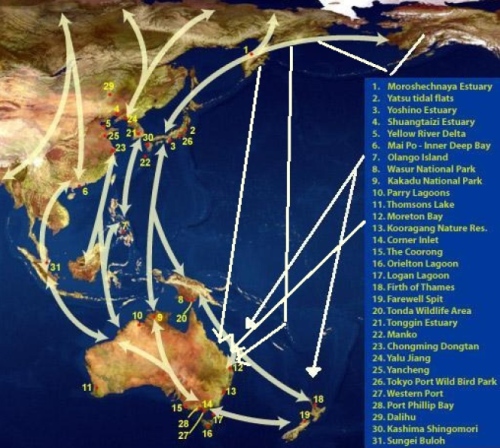
Roz spoke about some of the species which undertake migrations form eastern Australia to eastern and northern Asia.
Red-necked Stint
Rosalind said this species weighs only 30 grams. It makes an annual migration from eastern Australia to the high Arctic breeding grounds with a round trip of 25,000 km. Over 20 years a bird could travel 400,000 km equivalent of flying from the earth to the moon.
Eastern Curlew
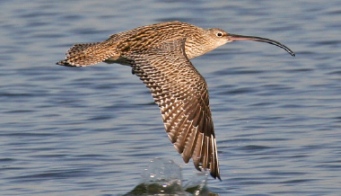 |
This species is considered vulnerable by the IUCN. It migrates from eastern Australia to the Yellow Sea region in China. Roz spoke about 3 birds which were tracked from Andersons Inlet (near Inverloch in Victoria) to China in 2011. The Curlew's departed Victoria from early to mid March, each making a non-stop northward migration of 8,500 km to the Yellow Sea in 7 days. The Eastern Curlews remained at the breeding grounds to early June and slowly migrated back to Victoria by early August. Their flying speed has been tracked at 41-84 km/hr (median 50.5km/hr).
Ruddy Turnstone
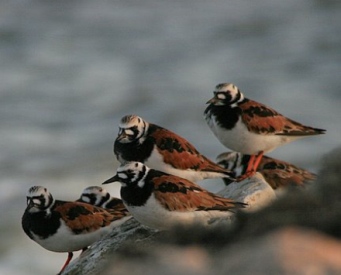 |
This species is normally found on rocky shorelines and ocean beaches. They have an average life span of about 9 years. Breeding commences at 2 years of age and they form monogamous pairs. Monitoring has been undertaken by fitting geolocators.
Tracking was undertaken in April to early June 2010. A flock travelled 4600 km to Taiwan in 6 days then onto the Yellow Sea, eventually ending up in the Arctic breeding grounds. Return migration was tracked from July to October. It was noted that some birds travelled the same route as their northward migration but some birds travelled a different Pacific route.
Rosalind described the migration of a tracked Ruddy Turnstone which departed Flinders in Victoria on 27 April 2009 and returned 8 December 2009, a journey of about 27,000 km. The same bird was tracked in 2010 and followed a similar flight path.
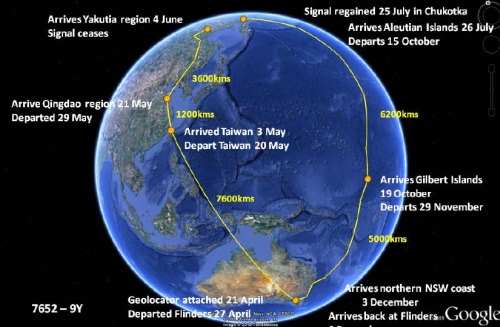
By tracking multiple birds over years it has been found that Ruddy Turnstones tend to have their own individual flight path. Tracking has also found that migrating Ruddy Turnstones can travel at speeds between 50 - 65 km/hr by seeking out the most efficient altitude providing favourable air currents.
Sanderling
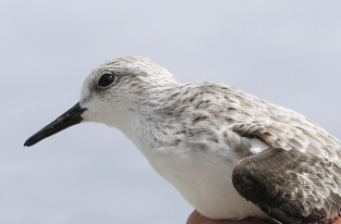
This species is predominately found on sandy beaches where they feed amongst washed up seaweed. Tracking has been undertaken using geolocators.
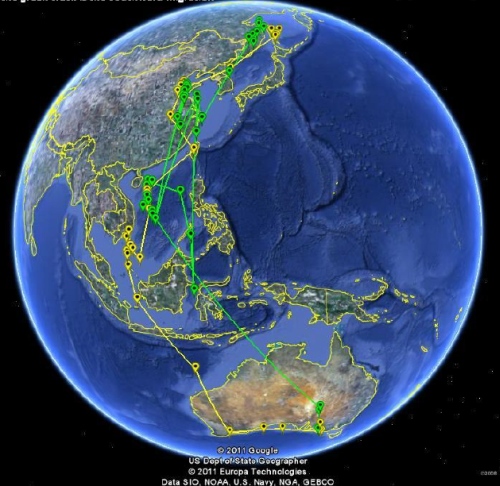
Roz spoke about the tracking map (above) which shows the northward (yellow) and southward (green) migration track of a Sanderling. The points indicate daily location. Clusters of points are locations where the birds made a stopover.
After breeding in Sakhalin Island in eastern Siberia the Sanderling was tracked heading south in August arriving back in Australia in October. The southward route passes through Korea and Japan whereas the northward path passes through Taiwan.
Little Curlew
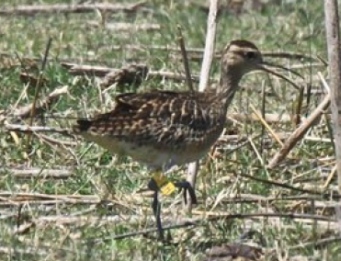
Roz spoke about some new important information about this species derived from tracking by satellite. The migratory path was unknown until recent tracking found a bird departed late April migrating via the Yellow Sea arriving in Siberia to breed in late May. They arrive back in Australia in September.
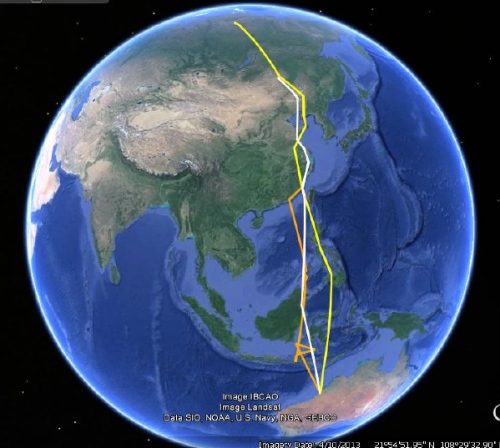
Red Knot
Roz said this summary information has been provided from studies by Chris Hassell from the Global Flyway Network.
The Red Knot has two sub-species Calidris canutus piersmai (mainly north Western Australia) and Calidris canutus rogersi (mainly eastern Australia and New Zealand) with roughly 20% of each sub-species mixing with the predominant sub-species. The combined population is estimated to be 220,000 but counts at the staging grounds in the Yellow Sea have only been in the 30,000 range.
Both sub-species migrate to the northern hemisphere to breed, Calidris canutus piersmai migrates to the New Siberian Islands whereas Calidris canutus rogersi (the species mostly found in Victoria) breeds at Chukotka in far eastern Siberia.
It has been found that some of the first year Red Knots arriving in Victoria remain in Victoria during their first winter. During their second year they migrate to New Zealand becoming New Zealand Red Knots migrating in and out of New Zealand to the northern hemisphere.
All northward migrations pass through a small area of the Yellow Sea at Bohai Bay, China. The eastern Australian and New Zealand sub-species arrives and departs earlier than the Western Australian sub-species)
Threats to migrating shorebirds
Roz spoke about the loss of mudflats in the Yellow Sea which are crucial habitat for migrating shorebirds. In China about 23% of mudflats are in reserves but have a loss of 0.5% p.a. and a loss of 1% pa. outside the reserves. In Korea only 12.1% of mudflats are in reserves with a loss of 0.83% p.a. inside the reserves and a loss of 1.8% p.a. outside the reserves.
The cumulative impact of habitat loss is dramatic. Over the last 50 years there has been a 65% loss of mudflats used by migrating shorebirds in the Yellow Sea.
At Roebuck's Bay mudflats, in China between 1994 and 2009, approximately 453 sq km of sea area, including 156 sq km of intertidal mudflats have been destroyed, a 36% loss of the total area of 428 sq km mudflats.
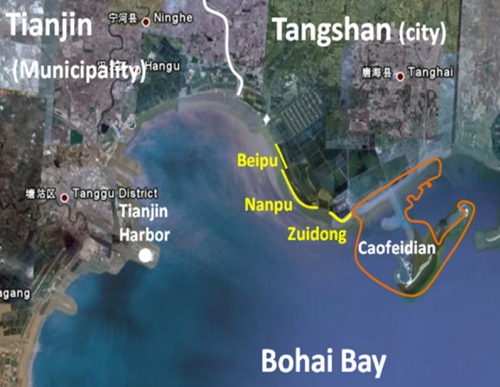
Mudflats in Bohai Bay, China are a major staging area used by Red Knots in their migration. Major port developments, including steel and chemical plants have been constructed using land reclamation which has reduced the available habitat. The area in Yellow being the only area remaining in the Yellow Sea used by Red Knots.
Roz acknowledged Clive Minton, Chairman of the Victorian Wader Studies Group, Chris Hassell, Global Flyways Network, Deakin University and the many members of the Victorian Wader Studies Group and the Australian Waders Study Group who contributed many hours in the field.
Key points from questions
- Australian shorebird monitoring commenced in 1978 using coloured bands and later coloured flags. Geolocators have been used for tracking small species since 2009, these have proven far more efficient than previous methods. In recent years satellite transmitters have been used.
- After their first year non-juvenile birds tend to migrate back to the same location each year.
See also: Global Flyway Network Australia
Southern Right Whale Migration Victoria’s own whale - Mandy Watson, Department of Environment, Land, Water and Planning, Victoria.
Mandy provided an overview of the Southern Right Whale and why we can call it Victoria's own whale. The Southern Right Whale is the only large whale species that occupies inshore habitats in Victoria for any length of time, also the only known calving ground in south eastern Australia is at Logans Beach, Warrnambool on Victoria's south west coast.
Description
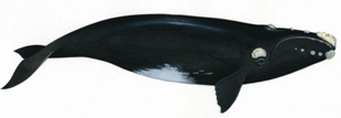
The Southern Right Whale Eubalaena australis is a baleen whale which grows up to 18m and can weigh 80 tonnes which is heavier whale than the more widely known Humpback Whale. Southern Right Whales are usually black, sometimes with a white underbelly. Distinguishing features include; a square shaped pectoral flippers, unique patterns of white callosities on their head and no dorsal fin.
Migration
Southern Right Whales migrate between their spring and summer feeding grounds between 400 and 650 South and their winter calving areas along southern Australian coastline.
The two main wintering habitats are calving grounds used regularly by females and migratory corridors in coastal areas where whales are regularly seen but have comparatively shorter residency times.
Mandy said information from observation records over a 30 year data set suggests there is a counter clockwise migration pattern with earliest (late April) and latest (October) sightings around the Portland area but these are generally not whales which have migrated to give birth. Calving whales tend to arrive in June. Departures occur September to October with a trend of later departures in recent years (7 out of last 10 years in October).
Abundance
Mandy provided an overview of the species decline where historical abundance in the southern hemisphere was estimated at 70,000 but by the 1920's fewer than 300 remained.
There are two genetically distinct Australian stocks (South West & South East Australia). The Southern Right Whale is now protected under the EPBC Act 1999 and is considered endangered. The South West Australia population is approximately 2,900 and recovering at the maximum biological rate. In Victoria it is considered Critically Endangered due to the low numbers and low rate of recovery in the South East Australian population which is estimated to be less than 250 individuals.
Sightings data
Mandy spoke about the Department of Environment, Land, Water and Planning incidental sightings database which commenced in 1985 to present. This database now contains important information regarding sightings, locations, dates and breeding. At the Logans Beach calving area a total of 69 calves have been recorded since 1985 an average of 2 per year but up to 6 in one year, but importantly there has been no detectable increase in calves over time which underscores the Critically Endangered conservation status in Victoria. Many said many of the seasonal whale sighting along the Victorian coast are mainly migratory whales.
Photo identification
Mandy has been involved with the South East Australian Southern Right Whale Photo Identification Catalogue (SEA SRW PIC) established in 2002. The catalogue now has about 3000 images which comprises 305 whales. Within that only about 12 whales use the Logans Beach area for calving. The photo identification has enabled seasonal tracking of movements between Victoria, New South Wales and Tasmania.
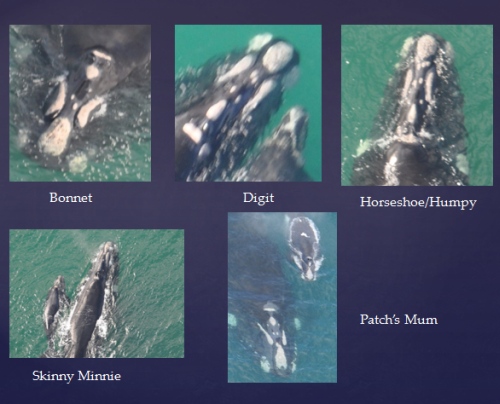
Some of the regular Southern Right Whales to calve at Logans Beach are identified by their unique callosities and given names by observers.
Genetics
Mandy said genetics work which commenced in the early 2000's showed evidence of significant differentiation between South Africa, South America, Australia (WA) and NZ (Patenaude et al 2007). Later analyses included additional samples collected from SE Australia to 2009 which showed significant difference between calving grounds in South East and South West Australia and New Zealand (Carroll et al 2011). Further analysis of genetic and stable isotope data was collected to 2012 (Carroll et al in prep).
Threats
The main threats for this species now that commercial whaling is banned is collision with vessels, entanglements, illegal whale watching and potential impacts from seismic surveys.
Conservation
The National Conservation Management Plan 2011, has identified Biologically Important Areas at Port Fairy/Warrnambool. Portland and Port Campbell are emerging BIA’s as well as the Vic/NSW border which has historic high use.
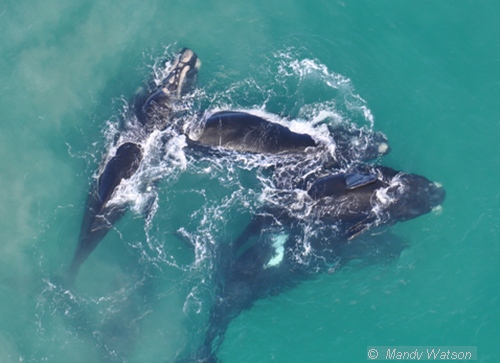
Unusual sighting of mating activity photographed off Port Fairy. Source: Mandy Watson, DELWP.
Key points from questions
- Southern Right Whales have a life span of about 60 years.
- Cows calve once every 3 years. Once a cow has calved it does not return to the calving area again for at least 3 years.
- There is a strong fidelity for females returning to the same calving grounds but identifying juvenile whales makes it difficult to determine if they return to the same areas.
- It is thought Southern Right Whales come so close inshore to calve is for the safety of calves from predators such as the Killer Whale.
See also:
Southern Right Whale - south east Australia monitoring project
Movement of Marine/Estuarine, Diadromous and Freshwater Fish using Mulloway, Australian grayling and Macquarie perch as examples - Jason Lieschke, Arthur Rylah Institute, DELWP, Victoria.
Jason is a Fish Ecologist at the Arthur Rylah Institute. He spoke about a range of studies that he is involved with regarding the migration of fish species that are marine/estuarine, freshwater to estuarine/ocean (diadromous) and freshwater only migrating.
Estuarine / Marine species: Mulloway
Jason spoke about tracking studies in the Glenelg River estuary, in south west Victoria. The Mulloway is a large fish about 1.8m long and is a valuable commercial and recreational species which is prone to overfishing.
Recent research has found the population structure is different between eastern and western South Australia (Ferguson in press) . Genetics indicate that the Glenelg population is similar to the Murray Mouth (east SA) population (Thomas Barnes PhD) . There is recruitment in Murray mouth area but no evidence of breeding within the vicinity of Glenelg River estuary.
Jason said his research is focusing on the patterns, timing of movement and habitat use between estuary and the surrounding Southern Ocean and where they go when they leave the estuary. Changes in water flows and salinity are studied to see how these might influence the movement of Mulloway.
Tracking movement
Jason explained a system of 19 receivers to detect acoustic tags of fish swimming past were set up in the Glenelg River from the estuary mouth to 67 km upstream.

A total of 31 Mulloway were captured, tagged with visual and acoustic tags and released between October 2008 and February 2009. Two fish were tagged in February 2010.
Environmental monitoring data
Daily discharge records were obtained from a gauging station at Dartmoor (70 kilometres upstream – top of estuarine influence).
Estuary mouth condition (Open/ Closed) was gained from the Glenelg Hopkins Catchment Management Authority.
Ten salinity loggers were used to monitor changes in salinity along the river.
Results summary
- Four fish either died, rejected their transmitters, transmitter stopped working or were angled within the first five days of tagging.
- An additional five fish exited the estuary within six days of implanting the transmitter.
- Twenty-two mulloway provided movement data.
- Fifteen of the 22 (68 %) were caught by recreational anglers.
- Fourteen (93%) kept, with only one fish released.
- Anglers phoned in thirteen of the fifteen mulloway caught.
- Six fish did not leave the estuary before being caught by recreational anglers, with all six caught within one year of tagging. (Three of these were captured within 75 days of tagging).
- Of the fish that went to sea, but re-entered the estuary; 5 fish were angled within two months of returning and 4 of these were angled within 15 days.
- One fish exited the estuary 17 days after tagging, then caught by a recreational angler near Murray Mouth two years later. (Approx. 400 km’s away).
Flows
Analysis of flow information found as the flows increased the average distance to the mouth decreased which indicates the Mulloway have a preference for more saline conditions.
Habitat preference
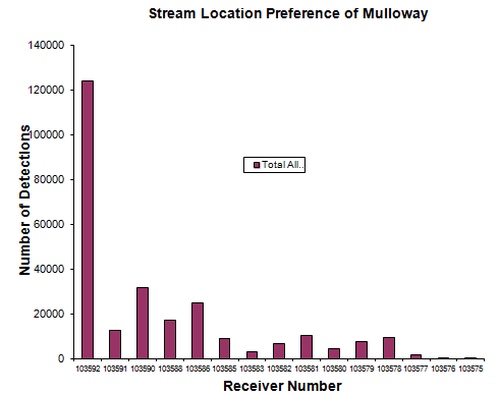
This graph represents the preferred location of Mulloway in the river (the highest number of detections being in the lower section of the river),
Movement
Jason found the Mulloway are quite a mobile species. Fish moved up to 50 km over a three day period in either direction (upstream or downstream) irrespective of time of day. He also found fish often schooled up (moved together).
Most fish tend to leave the estuary for the sea in December to January with a preference for high flow events. Some tagged fish came back between September to November which is believed to be the time when new fish enter estuary.
Recruitment
It was found that Mulloway leaving the Glenelg Estuary and travelling to the Murray Mouth were all estimated to be 5 – 7 years old which is the age they reach maturity.
It is known that the Glenelg system does not have any recruitment of juveniles but there is known recruitment to Coorong (Murray mouth) in late summer suggesting that the fish from the Glenelg system are leaving to possibly breed in the Murray mouth area.
Implications for management
Jason noted the huge angling pressure on Mulloway in the Glenelg River and the implications for management in South Australia and Victoria. As the Mulloway are so interlinked between the two areas he felt there needs to be greater cooperation between states to protect the species (Size ranges, flows, protection of breeding population, etc.).
The Glenelg system needs to be open during early summer for adults to exit to breed. This needs to be built into the Estuary Management Support System (EMSS) in place to guide artificial river mouth openings.
Environmental flows may be required in the Murray River to support spawning and the Glenelg River to allow migration especially if climate change occurs as predicted.
Further research
Jason spoke about further genetic studies required to determine where the Barwon, Maribyrnong and Yarra populations fit in. Are they part of the South Australian population or a separate subpopulation?
Mulloway tagging results 13 March 2019 from Glenelg Nature Trust.
Diadromous Species: Australian grayling
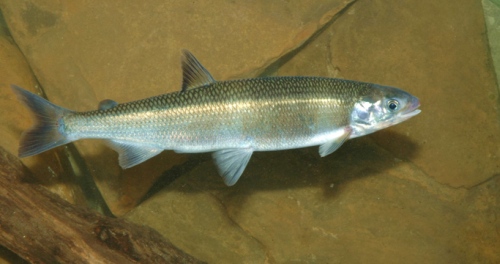
Jason provided a brief overview of research conducted by Dr Wayne Koster. He said research has shown Australian Grayling migrate down from a freshwater environment to an estuary environment to breed. Breeding takes place in April - May and coincides with increased flows or flush of the system. Once spawning has taken place the adult fish move back up the system leaving eggs and larvae in the estuary where they can be swept out to sea remaining for 6 months before returning into the river system.
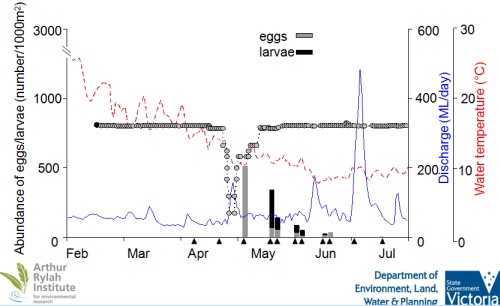
Chart showing the movement of Grayling downstream to spawn which coincides with a flush of the system in April - May.
Management considerations
Flows are an important cue for movement to trigger spawning which may need environmental water for the cue.
Barriers restrict movement (to and from spawning areas).
It is important to consider flows as cue for juveniles to migrate upstream (from Ocean).
Freshwater species: Macquarie perch
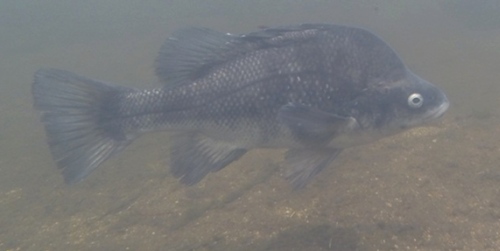
Jason provided an overview of research related to Macquarie Perch, flows, migration and spawning conducted by Dr Wayne Koster and Zeb Tonkin.
Research into a number of populations has shown that Macquarie perch can migrate distances of 100 km upstream to suitable spawning grounds which are usually at the bottom of a pool in run/glide areas just above a riffle zone. The spawning cue coincides with a high flow event in December.
Macquarie perch can establish populations in lakes where they have access to suitable spawning habitat e.g. Lake Dartmouth. Adult fish migrate from the lake in Spring to major tributaries to spawn where they can form dense aggregations in selected pools / riffles for several months. It has been found that at Lake Dartmouth there is spawning and non-spawning movement but only about 10% of the fish undertake spawning migrations in any year.
In summary, Jason said the specific timing of high flow events to suit each of the three species is a very important factor in their life cycle.
Jason acknowledged the following staff from ARI (DELWP)
- Anthony Steele-Cable (former)
- Justin O’Connor
- Lauren Dodd
- Justin O’Mahony
- Graeme Hackett
- Daniel Stoessel
- Jarod Lyon
- Zeb Tonkin
- Colby Bowden, Charlie Cooper and Cameron McCallum (FV)
- Scott Gray, Warrick Hamer and Frank Stemmer (Recreational anglers who donated fish for tagging)
- Dr Wayne Koster and Zeb Tonkin ARI – threatened species slides
- Dr Paul Moloney (Mulloway analysis)
See also:
Key points from questions
Mulloway are not listed as threatened at present but Victoria has increased the minimum size from 50cm to 60cm. In South Australia the limit is 65 cm in the Coorong and 75 cm in the ocean.
There is very heavy fishing pressure on Mulloway.
Funding is limiting research into Mulloway at other locations such as the Barwon River.
KEY POINTS SUMMARY
| Fitting of geolocators and satellite tracking of migratory shorebirds is providing new insights into their remarkable annual jorrneys. |
| Over its life time a small bird such as the Red-necked Stint could travel 400,000 km - equivalent of flying from the earth to the moon as it makes its annual migration from eastern Australia to the high Arctic breeding grounds, a round trip of 25,000 km. |
| The Yellow Sea between China and Korea provides crucial habitat for migrating shorebirds but the cumulative impact of habitat loss is dramatic with a 65% loss of mudflats used by migrating shorebirds over the last 50 years. |
| Calving Southern Right Whales tend to arrive in Victoria in June and depart September to October with a trend of later departures in recent years. |
| The only known Southern Right Whale calving ground in south eastern Australia is at Logans Beach, Warrnambool on Victoria's south west coast. |
| Mulloway are a mobile species, fish have been tracked moving 50 km over three days. |
| Migrating Mulloway leave the Glenelg system in December to January to breed in the Murray mouth area some 400km away. |
| High river flows during specific months of the year provides important spawning cues for Mulloway, Grayling and Macquarie Perch in their life cycle. |
See the full list of previous video conferences
Note: Images on this page are provided by speakers for use on SWIFFT and should not be copied to other publications without permission.


